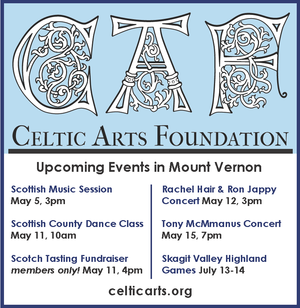The Plant Lady
March 4, 2015

March is a magical month in the valley — bright yellow sheets across the fields saluting spring with the color of the sun.
My father grew bulbs in the Puyallup Valley on my Uncle Charlie’s bulb farm, and I can remember as a child being thrilled by the fields of flowers that spread out as far as I could see every spring, especially the bright yellow daffodils.
Now that I live in the Skagit Valley, I am still in awe every year with the brilliant blooms that blanket the fields. The Skagit Valley devotes a whole month to the tulip, but the lovely yellow daffodil is still my favorite. Blooming before the tulips, daffodils are the perfect herald of spring.
The genus Narcissus, the daffodil, is comprised of about 50 species of spring blooming, bulbous perennial plants in the Amaryllidaceae Family, the Amaryllis Family.
They are native to a variety of habitats in Europe and North Africa, especially meadows and woods. Many thousands of cultivars have been developed. All are grown for their attractive flowers. Leafless stems bear between one and 20 nodding yellow, orange, or white flowers with spreading petals surrounding a trumpet-shaped corona.
There is a wonderful story about why the daffodil flower appears to nod and look down. The myth is as follows.
Once upon a time, in a far and distant place, there lived a young man, who was so handsome that all who beheld him loved and desired him. But the young man, the son of a god, was so proud he was unable to offer his love in return.
One of the women who loved him was the nymph Echo. She could not speak but only repeat what was said to her. While walking in the woods one day with some friends, the young man became lost and called out, “Is anyone here?” Upon hearing him, Echo stepped forward with open arms and replied, “Here, here!” He saw her but still refused her affections. Echo became so distraught she hid in a cave until nothing was left of her but her voice.
When the goddess Nemesis heard about poor Echo, she was so angered she caused the young man to fall in love with his own reflection. He could do nothing else for the rest of his life but try to kiss and embrace it. When he died, a flower grew on that spot, a flower that bears his name, Narcissus.
The daffodil, Narcissus bulb, dies back every year after flowering to an underground storage bulb. They regrow in the following year from this brown-skinned ovoid bulb. Narcissus’ are permanent plants that increase from year to year. They also tolerate cold temperatures up to -30˚ as well as high heat, making them very useful in many garden situations. Thousands are grown in our beautiful Skagit Valley for both bulb and bloom. They can be seen in late winter or early spring in our own gardens as well as in the fields all over the valley, their cheerful, bright yellow faces nodding in the wind.
Common names for Narcissus include Daffodil, Jonquil and, of course, Narcissus. All these are in the genus Narcissus.
In gardener’s terms, however, “Daffodil” generally refers to the large-flowered varieties, and “Narcissus” generally denotes the small flowered, early blooming types that bear their blossoms in clusters. “Jonquil” refers specifically to N. jonquilla and its hybrids.
Narcissi became an important horticultural crop in Western Europe in the latter part of the 19th century. By the end of the century, the Netherlands took over from England as the largest producer of bulbs. By the beginning of the 20th century, 50 million bulbs of the popular “Paperwhite” were being exported annually from the Netherlands to the U.S. “King Alfred” daffodils were introduced in 1899 and quickly dominated the already well-established market.
As I said earlier, my Uncle Charles Orton grew millions of bulbs in the Puyallup Valley. He grew many varieties including the popular King Alfred Daffodil.
On April 6, 1926, my aunt and uncle, Mr. and Mrs. Charles W. Orton, hosted a garden party for civic leaders from 125 towns in Western Washington. The party was arranged so the guests could see the many varieties of daffodils in bloom in and around their estate. Among the guests were the mayors from Seattle and Tacoma. The party was very successful and became a yearly event. The event was known as Bulb Sunday. Viewing the bulbs all over the valley became very fashionable and, unfortunately, created a massive traffic problem as the years went by.
In 1934 the Daffodil Festival and Parade was started as a way to use the blooms, which at that time were thrown away or used as fertilizer. Instead the blooms were used as decorations for a festival parade.
Automobiles were decorated with daffodils as well as bicycles. The parade travels through “Sumner, Puyallup, Orting and Tacoma on one day. This helped to cure the traffic problem. The Grand Floral Street Parade and Festival is a great and glorious event, much like our own Tulip Festival.
Happy, bright yellow spring.









Reader Comments(0)